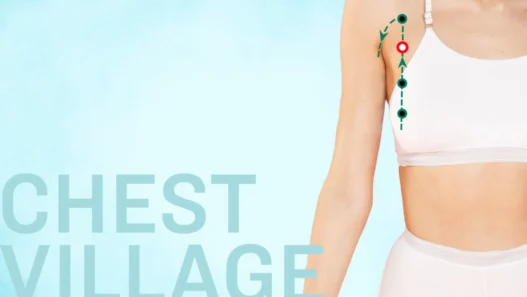“I have chest pain”—few words spark more immediate concern. However, not every pain or ache stems from a life-threatening issue. Instead of numbing the discomfort with over-the-counter pills, traditional Chinese medicine (TCM) invites us to tune in and ask: Where exactly is this coming from? Today’s acupoint, Breast Root (Ru Gen, ST18), is a helpful tool in this process. Located right under the nipple, it targets a specific type of discomfort in the chest area, offering a nuanced approach to self-care.
Why Ancient Healers Called Ru Gen a Root
Ru Gen first appeared in the classic “Zhen Jiu Jia Yi Jing” (“A-B Classic of Acupuncture and Moxibustion”), a foundational TCM text. The name itself gives the function away—this point sits at the lower border of the chest and acts like a structural anchor for the muscles in the region. Moreover, according to TCM principles, acupoints influence the tissues and organs they neighbor. For Ru Gen, this includes the chest muscles and mammary glands, making it a go-to point for addressing breast pain, swelling, and discomfort related to infections, such as mastitis.
A Useful Acupoint for the Chest and Beyond
Ru Gen shines when it comes to alleviating pain from tight chest muscles—especially the kind that makes it hard to take a full breath. This acupoint is also commonly used in women’s health, particularly for issues involving the breasts. Whether it’s general tenderness, distention, or inflammation, Ru Gen helps restore flow and relieve stagnation in the area. Its energetic role is to help “unbind the chest” or regulate the flow of vital energy through the chest, offering both therapeutic and preventative benefits.
Science Backs the Benefits of Ru Gen
Modern research is starting to show that these traditional points exhibit real physiological markers. One study used infrared thermal imaging to compare acupoint temperatures in women with hyperplasia of mammary glands and healthy controls. Ru Gen stood out with significantly elevated temperatures in affected people, suggesting a strong correlation with inflammation or energetic disturbance. The study also showed temperature asymmetries between the left and right sides of the body, highlighting how localized changes can carry diagnostic value.
Another study analyzed 312 clinical articles to map out effective acupuncture strategies for treating the same condition. Ru Gen was one of the most frequently used and centrally connected acupoints in successful protocols. It was consistently paired with other key points across body regions, reinforcing its reputation as a powerful chest-specific therapeutic tool.
How to Locate and Stimulate Ru Gen
The classical method for locating Ru Gen involves measuring four cun (approximately the width of a thumb at the knuckle) laterally from the body’s midline to the fifth intercostal space. Thankfully, there’s a shortcut. Most TCM practitioners simply trace a line downward from the nipple, which typically sits on the fourth rib, and stop just above the next rib down. Press around this area gently—if you find a spot that feels sore or sensitive, you’ve found the point.
How to Stimulate the Point
- Firm pressure: Press firmly for three to five seconds, then relax for three seconds. Repeat for one to three minutes on each side.
- Circular massage: Massage in small circles with your index finger or thumb for one to three minutes on each side.
- Herbal patch: Apply an herbal patch overnight for longer activation.
- Advanced methods: Acupuncture or moxibustion (a gentle heat therapy using dried mugwort) by a trained professional can deepen the therapeutic effects.
Precautions
Avoid Ru Gen if the area is bruised, injured, or highly sensitive. If you use herbal patches, choose gentle formulations—especially if your skin reacts easily. Keep in mind that, due to its proximity to the lungs, any acupuncture performed in this area should be conducted by a professional to ensure the correct technique.
Slow Down and Check In
Ru Gen invites us to pause and ask what our bodies are truly experiencing. Chest discomfort can come from dozens of sources—lungs, heart, muscles, digestion. Ru Gen won’t give you all the answers, but it’s a powerful tool to tune in and begin a conversation with your body. In some ways, those mindful moments of paying attention are as valuable as the energetic reset Ru Gen helps provide.
TCM expert Shihhsiang Hung reviewed this article for accuracy and clarity.
Originally published in Epoch Times on 8 July 2025























